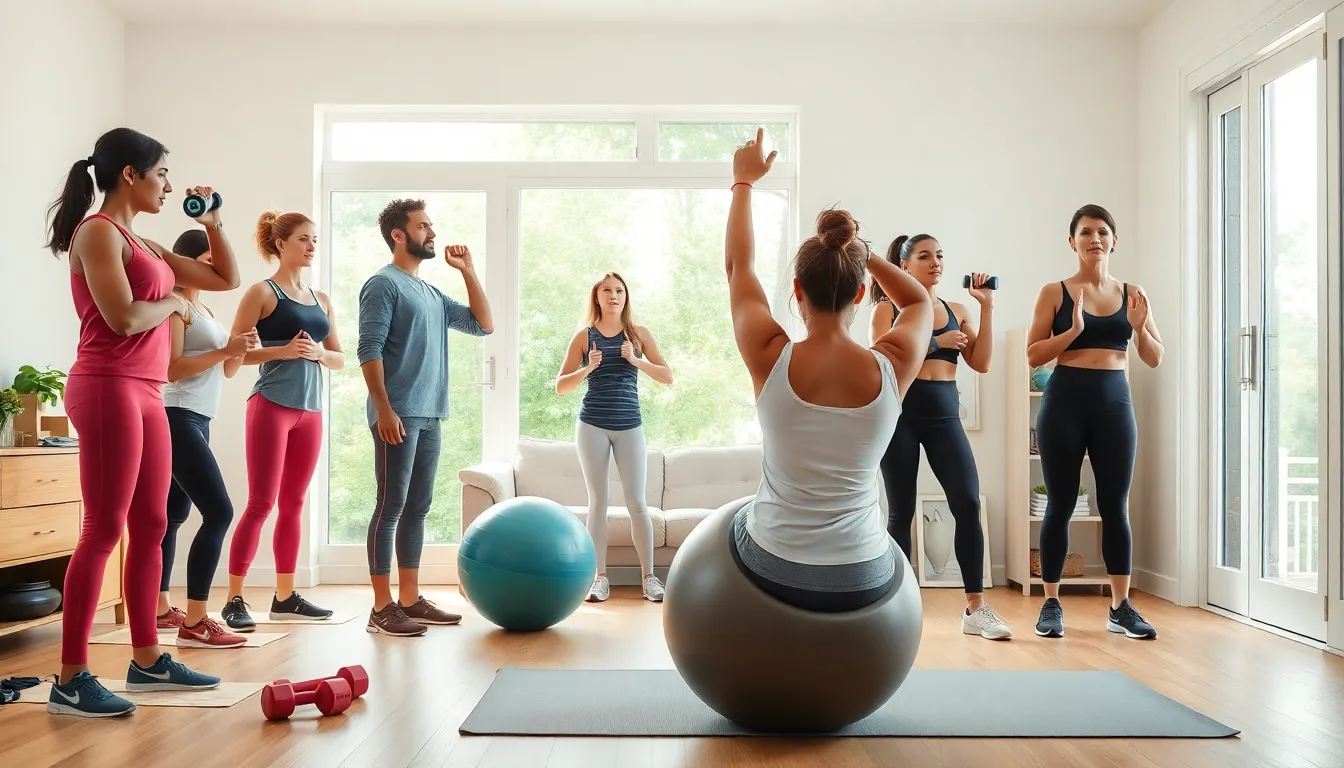In a world where gym memberships can feel as elusive as a unicorn, American home fitness is stepping into the spotlight. Picture this: no more awkward moments on the treadmill or dodging sweaty strangers. Instead, it’s just you, your favorite playlist, and a cozy corner of your living room that’s about to transform into your personal gym.
American Home Fitness
American home fitness has gained significant traction as individuals seek personalized workout experiences. The trend reflects a growing preference for exercising in the comfort and privacy of one’s home.
History and Evolution
Home fitness emerged in the early 20th century with the invention of simple exercise equipment. Innovations like resistance bands and stationary bikes laid foundations for a growing fitness culture. The popularity of home workouts surged in the 1960s with figures like Jack LaLanne promoting fitness-focused television shows. In the late 1990s, the release of home workout videos brought aerobic exercise into households across America. Advances in technology further transformed home fitness, with streaming services providing on-demand workouts. Today, this landscape continues to evolve as fitness enthusiasts embrace various platforms and equipment.
Current Trends in Home Fitness
Current trends reflect varied interests in home fitness routines. Virtual workout classes lead the charge, allowing participants to engage in live sessions from their living rooms. Personalized fitness apps cater to specific needs, offering tailored workout plans. Additionally, smart equipment like interactive mirrors and connected bikes enhances the home gym experience. An increased focus on mental well-being has also influenced home fitness, with yoga and mindfulness practices gaining popularity. Social media platforms amplify community support, encouraging individuals to share progress and stay motivated.
Equipment and Accessories

Home fitness requires specific equipment and accessories to support various workout routines. These tools enhance the exercise experience while promoting overall health and well-being.
Must-Have Equipment for Home Workouts
Dumbbells lead the list of essential equipment for versatility in strength training. Resistance bands offer a lightweight alternative while targeting different muscle groups. A stability ball acts as both a core strengthener and a useful tool for balance workouts. Adjustable benches provide an additional layer of flexibility in exercises, from chest presses to step-ups. Lastly, a yoga mat serves as a comfortable base for yoga practices and stretching routines.
Innovative Fitness Accessories
Smart kettlebells incorporate technology, tracking workouts and offering coaching feedback. Suspension trainers use body weight for resistance while enhancing strength and flexibility. Foam rollers assist with muscle recovery and can alleviate soreness after workouts. Jump ropes promote cardiovascular health while improving coordination. Fitness trackers monitor daily activities, encouraging users to stay motivated and reach their goals.
Popular Workout Programs
Home fitness options cater to various workout styles, making it easy for individuals to find programs that suit their preferences. Strength training and cardio workouts remain popular choices among American home fitness enthusiasts.
Strength Training at Home
Bodyweight exercises like push-ups and squats require no equipment, showcasing simplicity and effectiveness. Dumbbells and resistance bands enhance routines, targeting multiple muscle groups efficiently. Innovative tools such as adjustable kettlebells offer flexibility, allowing users to modify weight easily. Online platforms feature strength training programs that cater to all fitness levels, from beginners to advanced users, providing structured guidance. Instructors often include modifications to accommodate different abilities, ensuring inclusivity.
Cardio Solutions for Small Spaces
Jump ropes deliver an efficient, high-intensity cardio workout that fits into compact areas. Stationary bikes and compact treadmills offer excellent cardiovascular benefits while maintaining a small footprint, ideal for home gyms. Aerial biking workouts engage the full body, combining strength and cardio elements in one session. Streaming services provide a wide array of guided cardio workouts, focusing on interval training and dance. Engaging in programs that incorporate body movement energizes participants, making cardio fun and effective without requiring much space.
Benefits of American Home Fitness
Home fitness offers significant advantages, including convenience and affordability. Enjoying workouts at home encourages consistent engagement with exercise.
Convenience and Flexibility
Flexibility remains a key advantage of home fitness. Individuals can create their workout schedules without adhering to gym hours. Exercising at home allows for quick adjustments, perfect for busy lifestyles. One can simply roll out a yoga mat or grab weights when time allows. This ease of access leads to increased frequency of workouts. Comfort in a familiar environment enhances focus and motivation. Additionally, varying routines and experimenting with new exercises becomes seamless, fostering creativity in workouts.
Cost-Effectiveness Compared to Gym Memberships
Cost-effectiveness often drives individuals toward home fitness alternatives. Gym memberships, typically ranging from $30 to $100 monthly, can strain budgets over time. By contrast, investing in home fitness equipment proves beneficial for long-term savings. A one-time purchase of equipment like dumbbells or resistance bands often costs less than a year of gym access. Home workouts eliminate commuting expenses and time spent in traffic. Free online resources such as workout videos and fitness apps further reduce costs while maximizing variety in routines. Financial savings motivate more people to embrace home fitness options readily.
Challenges of Home Fitness
Home fitness presents several distinct challenges that can inhibit effective workouts.
Staying Motivated
Maintaining motivation can prove difficult when exercising alone. Distractions at home often lead to skipped workouts or reduced intensity. Setting specific goals and tracking progress can enhance accountability. Engaging in virtual workout classes or following fitness influencers on social media may also provide inspiration. Group challenges, even when done remotely, help build a sense of community. Finding workout buddies can foster a supportive environment that encourages consistency.
Creating a Suitable Workout Environment
Creating an ideal workout space at home is crucial for success. Limited space often poses a challenge, making it necessary to choose equipment wisely. Designating a specific area for workouts can help establish a routine. Ensuring proper lighting and ventilation contributes to a more inviting atmosphere. Investing in quality flooring or mats improves safety and comfort during exercises. Personalizing the space with motivational quotes or images can enhance positivity and focus.
Conclusion
The evolution of American home fitness reflects a significant shift in how individuals approach their health and well-being. With an array of equipment and resources now available, it’s easier than ever to create a personalized workout space that caters to individual needs. The flexibility and convenience of exercising at home empower people to prioritize their fitness without the constraints of traditional gym settings.
As trends continue to evolve, the integration of technology and community support plays a crucial role in motivating individuals to stay active. By embracing the home fitness movement, many are discovering not just physical benefits but also improved mental well-being. It’s a journey that encourages everyone to find joy in movement and cultivate a healthier lifestyle at home.

